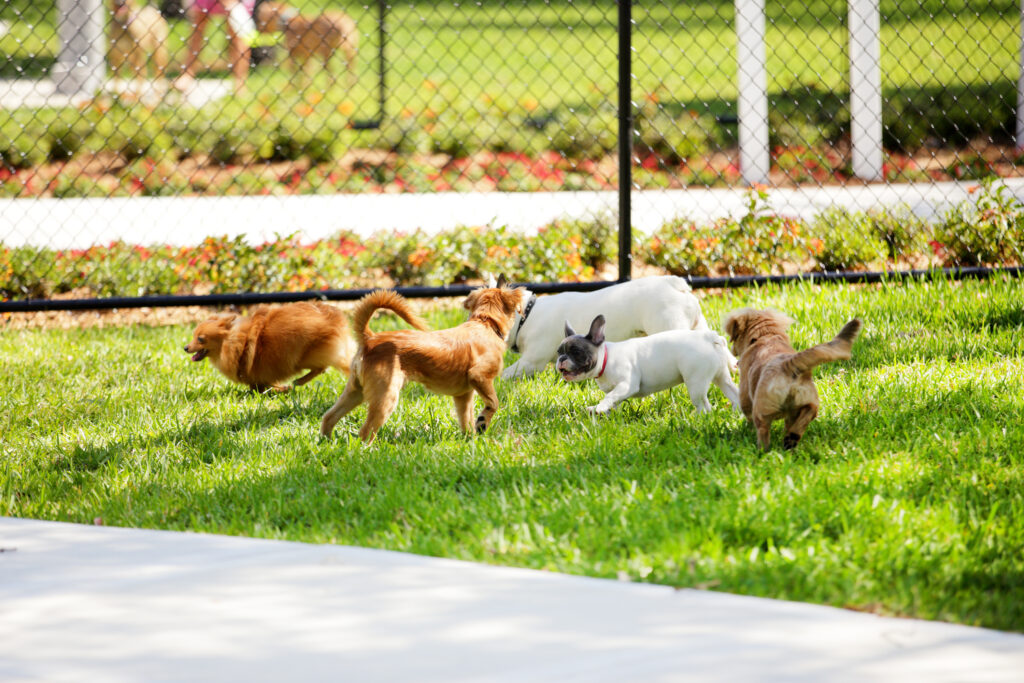As a dog training community, we are always seeking to provide our dogs with positive experiences. Introducing our four-legged family members to new dogs, new people and new environments helps to build confidence and shape them into well-rounded companions.
Taking your dog to your local dog park may seem like a natural way to tick those novel experiences off the list. After all, at the dog park, the likelihood is that your pup will encounter those new dogs and enter a new environment. If all goes well, then your dog will have an amazing time running around with some new friends who have a similar temperament and disposition to themselves. A 2018 survey by the National Recreation and Park Association (NRPA) found that dog owners overwhelmingly agree with this – over 90% of Americans believe dog parks provide benefits to the community.
But what happens if – or when – all doesn’t go well?
Unfortunately, we’ve all heard the story (some of us may have even witnessed it first hand) of the irresponsible dog owner who turns a blind eye and allows their dog to create chaos at the dog park. “Oh, someone’s in a playful mood today!” they exclaim, as their dog charges around with reckless abandon, bullying other dogs (sometimes resulting in injury), and causing consternation among human onlookers. If your dog is the victim of an out-of-control bully at the dog park, it can be traumatic and create its own behavioral problems.
We have spoken before about the importance of effective socialization. While there is no doubt that the vast majority of dog owners are well-intentioned when they bring their dog to the dog park, do the benefits actually outweigh the downsides? In this article, we’ll weigh up the pros and cons of dog parks, and offer some alternative ideas for effective socialization.
Advantages of Dog Parks
A dog park can provide several benefits for your dog. They can also be a great resource for the community – particularly if the dog park is located in a densely populated, urban area with few other options.
Here are a few of the advantages of bringing your dog to a dog park:
Interactions with other dogs
In the same way as constant isolation can be unhealthy for humans, so the same theory can be applied to our canine companions. Bringing your pet to the dog park gives your pup the opportunity to interact and play with unfamiliar dogs. If they strike up a good rapport with one or two dogs in particular, this may give you the opportunity to arrange private puppy playdates away from the dog park.
Meeting new people
Some dogs suffer with anxiety or fear around people; the dog park can be a way to desensitize them by having other dog owners interact with them. Providing the situation is safe for all parties, encouraging other owners to feed a couple of treats and provide positive reinforcement to your dog can help to build their confidence around unfamiliar people. Please note that if your dog is particularly fearful or anxious, the dog park may not be suitable.
Off-leash benefits
If your dog doesn’t have a reliable recall, or if you live in a confined space (such as an apartment), your dog may not have the opportunity to run around off-leash. The dog park enclosure means that your dog can have the freedom to explore of their own accord, increasing their independence and reducing the potential stress of them bolting and running away.

Physical exercise
While some breeds need more exercise than others (depending on their breed characteristics, size and other factors), all dogs need some form of physical exertion for their health and wellbeing. A trip to the dog park is a great way to unleash some of their energy and ensure they get a sufficient workout.
Mental stimulation
Keeping your dog mentally stimulated is just as important as maintaining their physical health. A lack of mental stimulation can lead to problematic or destructive behavior. Going to the dog park will undoubtedly make your dog think and offer that mental stimulation, through the combination of the environment, other dogs and new smells.
Disadvantages of Dog Parks
As we covered in the introduction, the dog park isn’t all sunshine and flowers, and there are several potential downsides for your dog. Of course, every dog park is different, and the majority of dog owners are responsible; but these factors are still worth considering.
Here are a few of the disadvantages of bringing your dog to a dog park:
Danger from aggressive dogs
Some dog owners often misdiagnose their dog’s aggression for play. The reality is that many dog owners are not professional behaviorists and are therefore not qualified to identify their dog’s behavior. The danger for your dog is that they could be the victim of an attack by a reactive or aggressive dog, which could cause significant physical harm or injury.
Size differentials
Although some dog parks do have multiple enclosed spaces to separate dogs based on size, many do not. Even for those dog parks which do have separate spaces for smaller dogs and larger dogs, many dog owners will place their medium-sized breed in with smaller dogs to keep them away from the truly large breeds. This can unintentionally create issues if a tiny, toy breed interacts with a dog that is several times bigger than they are.
Hygiene, cleanliness and disease transmission
Among scientific studies of dog parks, hygiene issues have been frequently cited as a problem. Dog parks are rarely cleaned and rely on the owners to pick up after their pup. In addition, other diseases can be unknowingly transmitted from dog to dog, especially as there is no way to verify the health and vaccination status of other dogs at the park. This can lead to an increased risk of your dog catching a disease or illness.

Forming bad behavioral habits
Just as you wouldn’t want your child hanging around with other children who may contribute to forming undesirable habits, the same is true for dogs. Your dog will observe and may begin to copy dogs who are exhibiting other behavioral traits.
Negative experiences
Ensuring your dog has positive interactions should be at the forefront of any planned socialization activity. With all of the variables in play, there is simply no way to guarantee that your dog will have a good experience at the dog park. You are entirely reliant on the behavior of unfamiliar dogs, and the hope that fellow dog owners are as vigilant as you are.
Dog Park Alternatives
If the potential downsides of dog parks mean that you are concerned it may not be the ideal activity for your dog, there is good news! There are alternatives which can still offer many of the benefits of dog parks, including socialization, off-leash exploration, and interaction with other dogs and people, such as the following options:
Group classes
There are several benefits to group class dog training. They allow your dog to learn a variety of new skills under the instruction of a professional dog trainer. Importantly, the instructor for your group class will be able to quickly recognize behavioral tendencies in other dogs, which can eliminate the potential for negative experiences.
Private meetups/puppy playdates
Arranging a private meetup or puppy playdate with a dog and owner that you know reduces the unknown quantities that unfamiliar dogs can bring. If you are short of space but are worried about the sanitation at your local dog park, SniffSpot and other similar providers offer rental spaces where your dogs can run off-leash in a secured space.
Take your dog on a public outing
Bringing your dog out in public gives them the opportunity to meet with fellow dogs and their owners. Pet stores are a natural choice, but home improvement stores, downtown areas and other public places can offer mental enrichment for your pup. If you’re looking for inspiration, check out our list of public places you can take your dog.

In conclusion
As we have explored in this article, there are several pros and cons to bringing your dog to a dog park. There are alternatives available which offer many of the same benefits, without taking on the risks that dog parks can bring.
Ultimately, as your dog’s guardian, you must weigh up the benefits and downsides for yourself. If you are unsure about your local dog park, you may consider visiting on your own (without your dog) and observing the typical behavior of the dogs who are there.
Related posts

Follow These Car Travel Safety Tips For Your Dog
Traveling with your dog in your car can be fun – but keeping them safe should be your top priority.

Why Dogs Are The Best Pets
Okay, so we all know that dogs are the best pets – but now we’ve collated the science and data to prove it.

New Puppy Checklist: Here’s What You Need
Bringing a new puppy home? Here’s the list of everything you’ll need to give your new pup the best start in life!


You must be logged in to post a comment.